Just don’t think anything bad! I'm not so lazy that I'm too lazy to reach out to turn on the light. It's just that "these gallant builders", as always, got it all mixed up. The switch was installed so inconveniently that it is easier to wash your hands in the dark than to stomp to the end of the corridor, turn on the light, then stomp back and so on every time. Households swore, and I myself, I confess, was not happy with this situation. And then suddenly I thought: " I'll buy myself a motion sensor, I'll put it in the bathroom, let it turn on the light when someone enters, and then turns it off. "With this saving thought, I went to the electrical store and returned from there with a magic box. I'm ready to tell you what came out of my venture.
In any self-respecting electrical store, you will be offered a choice of several sensor options. There are separate devices, there are combined with a spotlight or a simple lamp. There are those who "take" only at a short distance, others "reach from fence to fence".
My case is just one of the options for using motion sensors. For example, you can install them in a summer cottage and connect with. One has only to go out into the courtyard and it immediately becomes light. Can you imagine what a surprise awaits someone who climbs over the fence in the hope of "whistling" something valuable. Let's say dig up your pride -.
If you supplement the system of motion sensors and searchlights with a pair of kind Rottweilers released into the garden for the night, then you will only have to watch through the window as the unlucky gentleman of fortune flees away from the ferocious dogs, which nevertheless overtake him at the moment of climbing over the fence and perform the classic act of ripping his pants ...
Seriously speaking, motion sensors can noticeably reduce energy costs, just start using them wisely. I'm not even talking about the fact that they are irreplaceable assistants in the design of security systems and other interesting engineering solutions.
Motion sensor IEK DD010
This is not to say that I went to the store specifically for this sensor. It was just enough for my tasks. In a large room, you would have to put something more serious or even use several sensors connected in a certain way.
Motion sensor DD010 seemed like a suitable choice and I bought it.
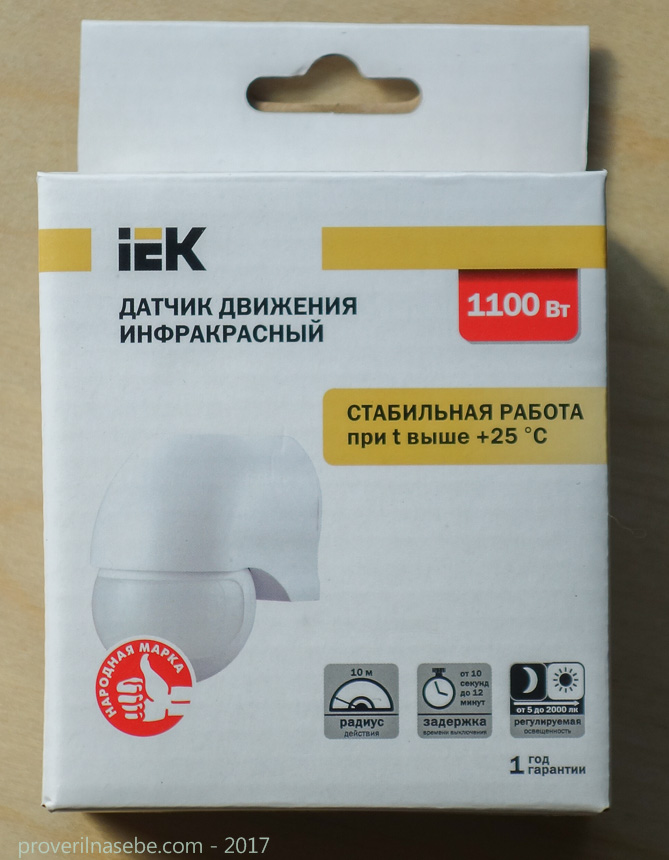

Inside the neat box, the sensor itself, an instruction in Russian and a pair of screws with dowels for attaching the device were found.
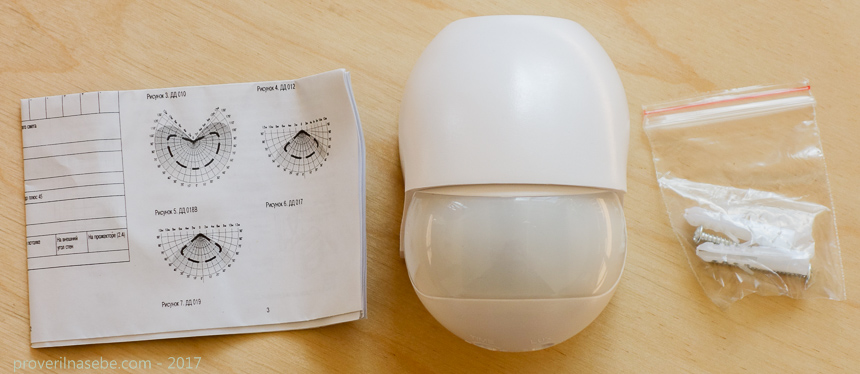
The device itself is small, not at all heavy. The ball-shaped sensor housing can be rotated slightly to the left and right. But the steering angle is relatively small. You will not be able to rotate it 180 degrees or point it down. This must be taken into account during installation.
The manual offers a description of several sensors at once. Therefore, we must always remember that we have a device marked DD010 in our hands, and look exactly at its parameters.
Of the features and specifications.
The motion sensor is powered directly from the electrical network; no adapters required. The device can be installed on a wall or ceiling, according to the situation.
Working temperature range- from -20 to +40 degrees. You can put it on the street, operate it in winter. The protection class IP44, in principle, allows you to leave it outdoors without special measures against precipitation and dust. However, I would make some kind of rain shade.
Radius of action devices - up to 10 meters. This means that for a room, kitchen, bathroom, entrance, porch, it is quite suitable. But for a hangar, workshop, large garden - no longer. You need to buy something more powerful or use a whole network of the same low-power sensors. Sometimes you really have to put several pieces of them. For example, if the room is L- or U-shaped.
Maximum power connected devices - 1100 watts. That is, light bulbs, small chandeliers, loudspeakers, tape recorders, and other household appliances can be connected. For example, you can connect a siren.
But an electric kettle, iron, heating radiator and other more powerful household appliances require a different sensor.
Setting up the motion sensor
How long does it take for the motion sensor to turn off the light?
One of the questions asked by people who know about motion sensors only from science fiction films is: "How many minutes will the light turn off after I leave the room." And it’s true. Let's say we went into the bath. The light turned on automatically. Then they went out. The light does not go out immediately. How long will it take?
Inexpensive motion sensors do not have the ability to set this parameter. They are preprogrammed to switch off after, for example, three minutes. Perhaps, in some cases, this is a completely normal interval. But, say, if you ran into the bathroom, just rinsed your hands in 15 seconds, and the light will remain on for another three minutes after that, then the energy saving, which I mentioned earlier, seems very doubtful. Perhaps you will still think whether it is worth washing your hands once again :).
Have DD010 you can set the time interval after which the device turns off after the sensor is triggered, in the range from 10 seconds to 12 minutes. This is very convenient and really saves energy.
For example, set the duration to 10 seconds. We went in, the light came on. As long as you are indoors and move at least slightly, the light will be on. And it will turn off 10 seconds after you go out and close the door.
However, if you are stationary, the light will also turn off. Therefore, it makes sense to set different time intervals for different rooms. In addition, it is worth remembering that electrical appliances, for example, light bulbs, are at the greatest risk of burnout just at the moments of switching on and off. Therefore, it is worth setting such a delay before turning off in order to exclude situations with constant "blinking" of the light in the room. As a rule, the time interval is determined empirically. In our particular case, it was about half a minute.
Why turn on the lights in the room during the day?
This is another question that somehow does not come to mind when buying a motion sensor. Only after you bring the new thing home and install it, for example, in your kitchen, you suddenly face this unexpected problem.
Imagine: it's evening, it's already dark outside, you enter the kitchen and the light turns on itself, as it should be. You leave the kitchen - after a while the light goes out. This is the normal option.
Now this is an example: it's daytime outside, and it's already light in the kitchen. You enter the room and suddenly a light comes on. What for? After all, it is light even without a lamp! If you own an inexpensive motion sensor, there is only one way to solve this problem - go to the hallway and turn off the light with a conventional switch. In the evening, when it gets dark, turn it on again and then you can fully enjoy the work of the automation. True, some unpleasant aftertaste will remain.
In normal devices, in addition to the motion sensor, another sensor is installed - the light sensor. You can configure it in such a way that when the light is bright enough, the motion sensor does not work, but starts working only with the onset of darkness.
Take a look at these settings on my device:
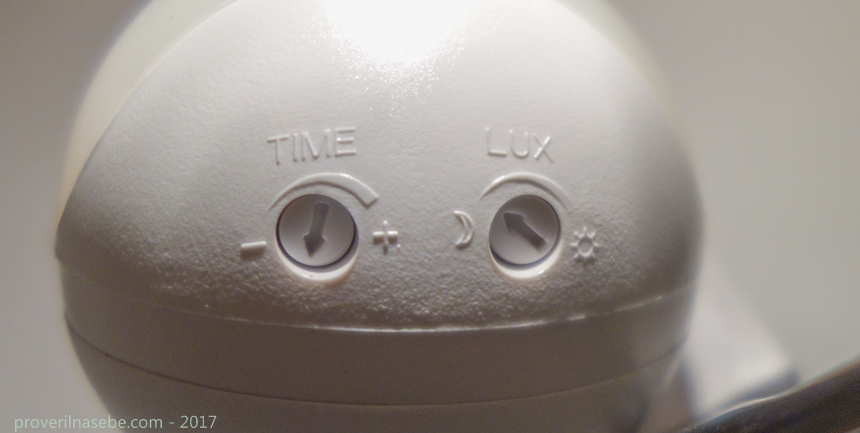
Installation TIME is the time before shutdown, which we have already discussed. But LUX- just allows you to set the illumination threshold, after which the sensor starts to work and turn on the light. By moving it with a screwdriver to position " Darker" or " Lighter", you can set the value at which the light starts to turn on only at dusk.
It is clear that in closed rooms this is not relevant. But, if there are windows in the room ... And in general, the motion sensor can turn on not only light bulbs, but also other devices, for example, heaters.
For example, if you want your greenhouse to turn on the heating radiator at night, set the LUX parameter and sleep well. Just first check if you can connect a device as powerful as a radiator through your specific sensor. Perhaps, for this specific task, you will have to buy another device designed for greater power.
Connection diagram and installation of the motion sensor
If you yourself are not very strong in electrical matters and are even afraid to take a battery in your hands so that you do not "get shocked", then the installation of the motion sensor should be entrusted to some familiar specialist. He will cope with this task quickly and easily.
If you want to try your luck on your own, then you need to act as follows:
Step-by-step instructions for installing a motion sensor
Step 1... De-energize the line on which the installation will take place. To do this, simply turn off the light with a switch. For greater confidence, you can turn out the plugs or, in general, go and de-energize the whole house (just kidding).
The two wires coming from the light bulb must be connected to the red and blue wires of the sensor using the supplied connector:
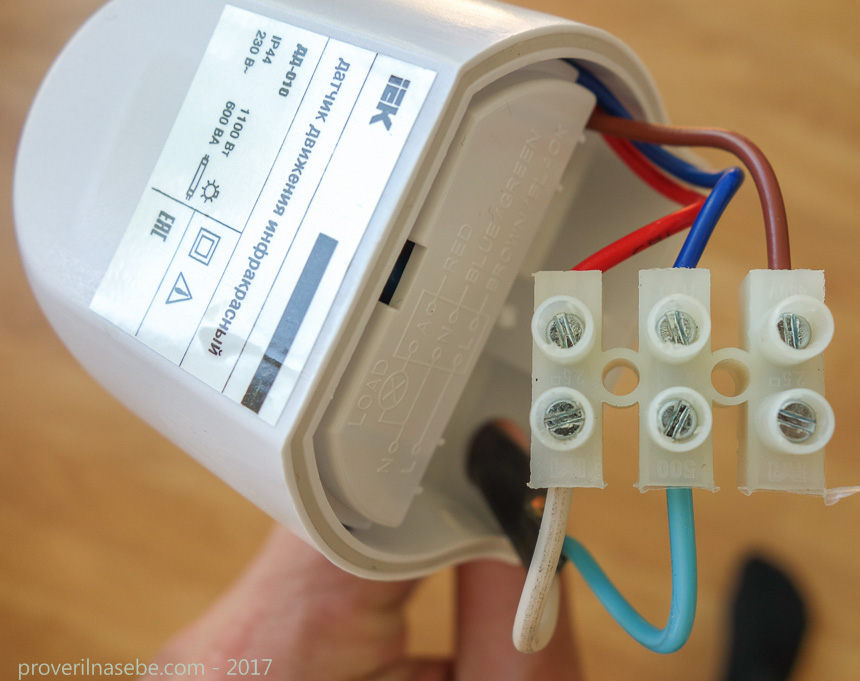
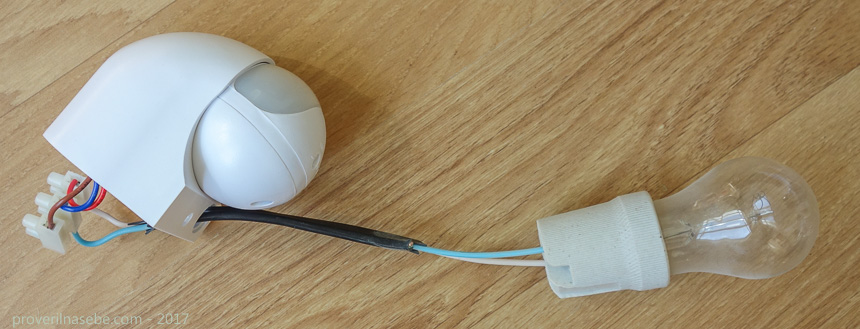
Step 3... We connect the electrical wires that stick out from the ceiling.
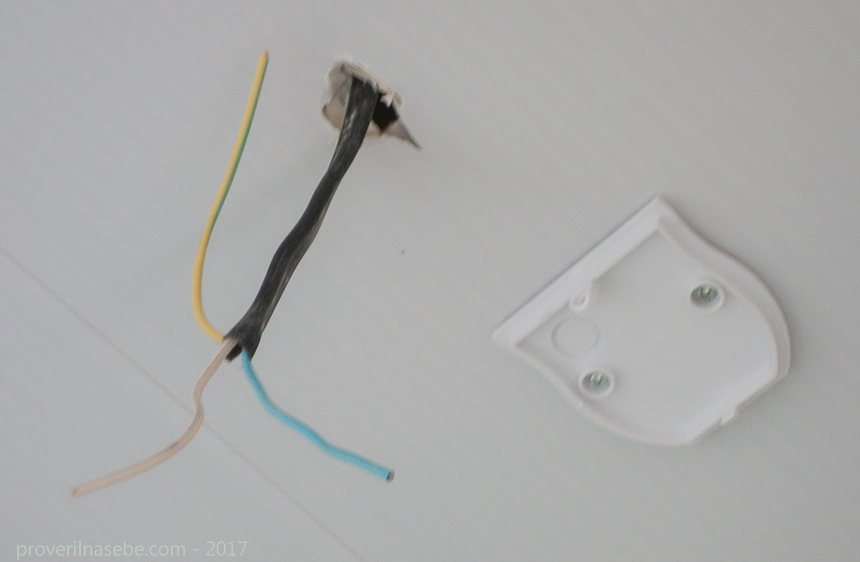
It is important that the connection goes exactly according to the diagram. It is included in the instructions and even printed on the motion sensor itself:
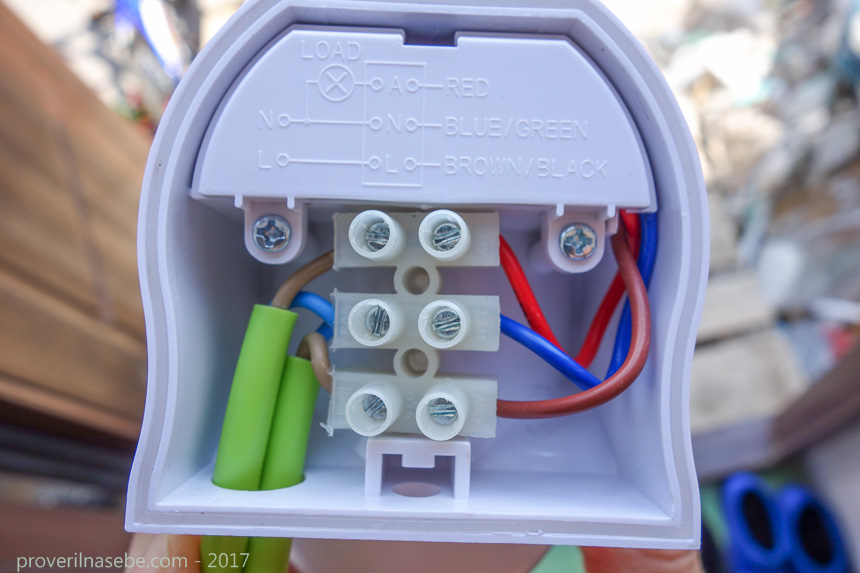
The letter "N" denotes the "zero" of the electrical network, while the "phase" is denoted by the letter "L". The wires protruding from the ceiling must be properly connected. In order to distinguish "phase" from "zero", you can use a conventional electrical voltage detector. It is not that expensive and is sold in any self-respecting electrical store. In general, the thing on the farm is very useful. I recommend purchasing. It costs a penny (around 50 rubles), but it can easily save life when fiddling with electricity.

In my particular case, the blue wire turned out to be "zero". It was him that I connected to the middle terminal. One of the wires from the light bulb was attached to it. Brown wires were connected to the outer terminals. One from the light bulb, the other from the one that was sticking out of the ceiling.
The confusion with the colors of the wires in my photographs is due to the fact that the first pictures I took with standard wires that were left by the builders. However, they turned out to be very thick and not flexible enough. No matter how hard I tried, I could not complete the editing. Therefore, at some point, the standard wires were replaced with more flexible ones - green ones.
So that you have a clear understanding of how to connect a motion sensor to a light bulb and wires from the ceiling, I give below the electrical connection diagram:

Hopefully now everything falls into place.
Step 5... Mounting the sensor in a regular place
The location for the sensor must be chosen so as to exclude false alarms. For example, if a door is always open in a room and someone walked past it without going inside, an incorrectly located sensor will react and turn on the light.
Therefore, before attaching the device to a wall or ceiling, it is worth testing the entire system in action, so that you do not have to drill new ones and cover up old holes later.
In my case, the finished system looked like this:
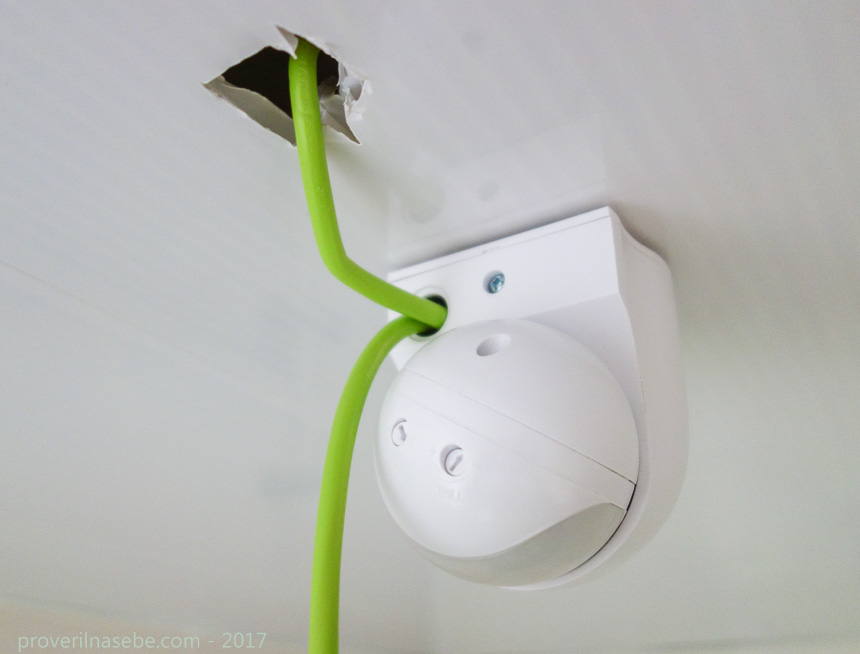
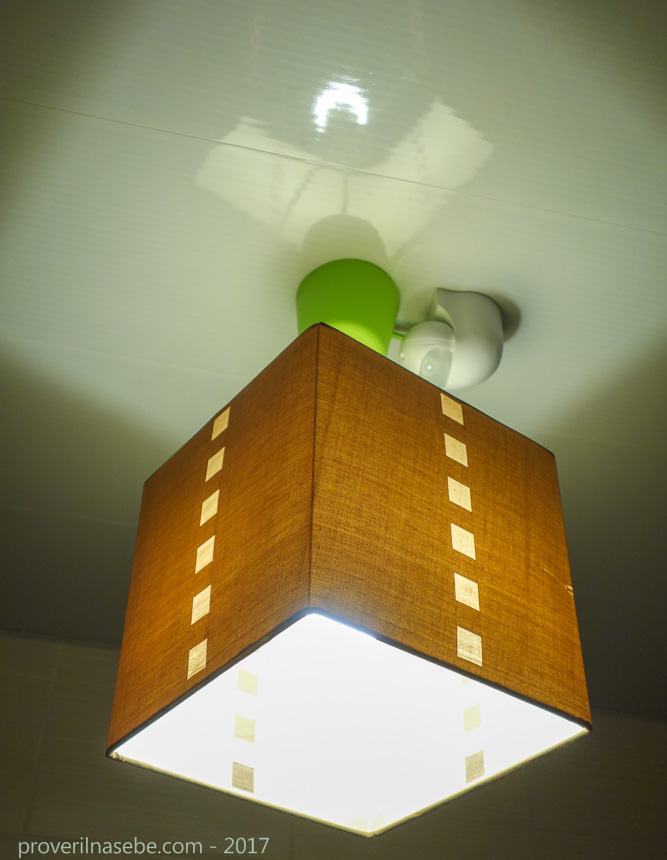
I know the position of the sensor looks somewhat controversial. It seems to be covered by a plafond. However, the latter does not interfere with the operation of the system at all, since it is "empty" inside.
Result - the problem with the incorrectly installed switch is solved. A motion sensor worth 380 rubles has saved a lot of time, nerves and, possibly, electricity.
Why is it possible? Probably because at home we do not often forget to turn off the light in the bathroom. But just imagine what benefit this system will bring in a public toilet!
Conclusion
Motion sensors are very useful devices in industrial systems. With their help, they install alarm systems, save energy and do a lot of other interesting and useful things. Alas, in everyday life these devices are still used rather as an exotic thing. Usually people have a lot of other things and desires that require money.
However, I believe that over time, the average weighted person will appreciate the benefits of a motion sensor. This is one of the building blocks of the so-called "Smart Home" system, which relieves the owner of unnecessary movements and allows you to monitor your home from any "point of the ball".
Turning on a bathroom light is just one example of a motion sensor application. However, it is worth turning on your imagination and you yourself, without someone's prompts, can easily find a few more examples where the device could take over some routine functions in your apartment, house or office. I wish there were such sensors that include imagination :)

